Arwah Cave Is An Awesome Spot For Your Trip To Meghalaya In 2025
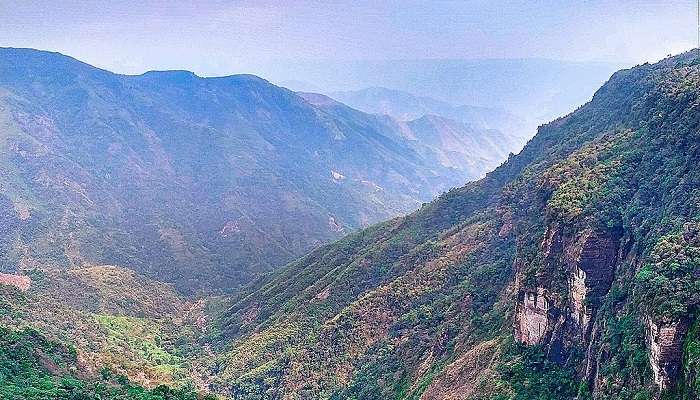
Arwah Cave is one of Meghalaya’s most famous caves accessible to regular visitors. It is renowned for its fossils which you can observe in the lit-up interiors, especially towards the end of the cave. You will find crustacean shells and fish bones fossilised in the limestone walls of the cave. Arwah, apart from being a place for natural history enthusiasts, will also surprise you with its many turns and corners – a maze where you are walking one minute under a high cave ceiling, and sliding the next minute through a narrow passageway that leads to other sections. The underwater streams have continued to flow through these ancient cave formations for millennia.
History Of Arwah Cave

Arwah Cave was discovered until recently and was least explored. It is very dark and creepy inside, especially when crawling through the narrow tunnels. There are many chambers and narrow passages in the cave. Arwah Caves are known for their limestone formations and the fossils, which are believed to be millions of years old. Explorers and adventure lovers have spotted various fossils in the shape of fish, dog skulls, etc. The formations inside the cave are bent and carved naturally so that people can pass through them quickly. A certain section of the cave holds the formation of stalagmites and stalactites. There is also a stream that flows inside the cave.
Must Read: Places To Visit In Meghalaya
Places To Visit Near Arwah Cave
If you are planning a trip to the caves,, you must note these spots for your visit. Here is a list for you:
1. Dainthlen Falls
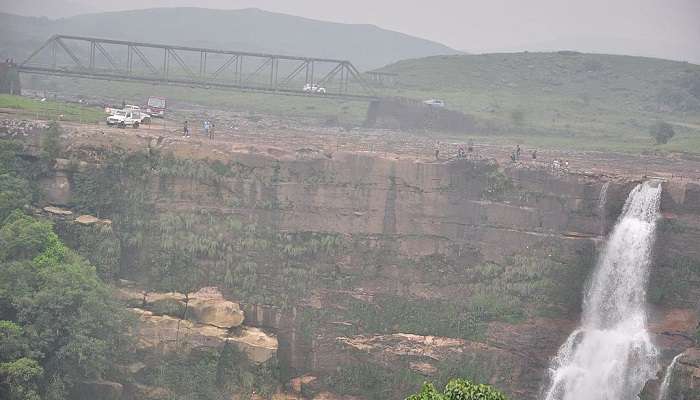
At a distance of 11 km from Cherrapunji Bus Stand, Dainthlen Falls is a gorgeous waterfall located in Cherrapunji, Meghalaya. It is one of the most popular waterfalls in Meghalaya and one of the most important places to visit in Cherrapunji. Cascading down from a height of about 90 m, Dainthlen Falls is among the famous waterfalls in Cherrapunji, attracting many tourists every year. There is a small legend associated with the name of this fall. According to locals, there was a huge demon python named Thlen who was drenched in greed and power. Some brave men caught the animal and destroyed its hood with a huge stone near this fall. Tourists visiting the waterfall can explore the natural rock carvings of the snake, which represent the symbol of evil, greed, and corruption.
Location: Dainthlen Road, Cherrapunji, Meghalaya
Distance From Arwah Cave: 8.9 km
2. Nongriat
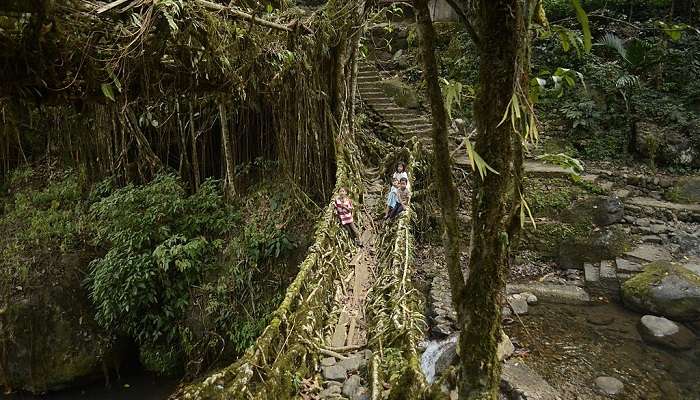
Nongriat is a village in the East Khasi Hills district of Meghalaya State, in north-eastern India. It is perhaps best known for its living root bridges, one of which is an impressive double-decker suspension bridge called Jingkieng Nongriat. The village has three functional root bridges. These are crafted by hand, as the Khasi people have done in the Khasi Hills for centuries, intertwining and weaving together the aerial roots of banyan trees on opposite sides of a stream-filled gorge.
Location: East Khasi Hills district, Meghalaya
Distance From Arwah Cave: 16.4 km
Suggested Read: Things To Do In Meghalaya
3. Noh Ka Likai Falls
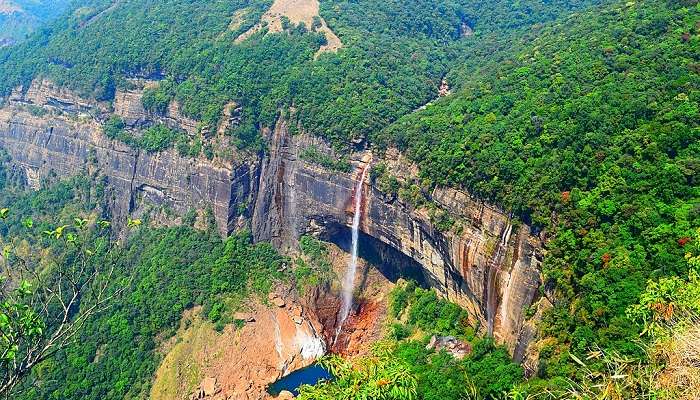
Nohkalikai Falls is the tallest plunge waterfall in India, at 340 m (1,115 ft). It is located in the Indian state of Meghalaya, near Cherrapunji (now known as Sohra), one of the wettest places on Earth. Nohkalikai Falls is fed by rainwater collected on the summit of a comparatively small plateau, and its power decreases during the dry season, from December to February. Below the falls is a plunge pool with water of an unusual shade of green.
Location: Nohkalikai Road, Meghalaya
Distance From Arwah Cave: 5.8 km
4. Double Decker Living Root Bridge
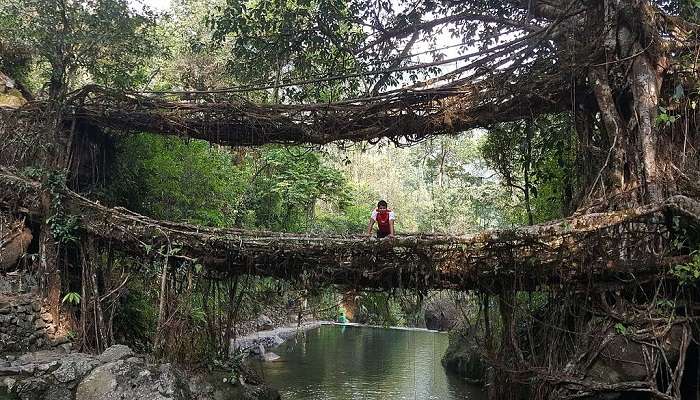
This is a living root bridge in Meghalaya, and it can be reached by trekking 45 km or 6500 steps from Cherrapunji. There is also a waterfall nearby. Due to tourism, the health of the root bridge has degraded. Meghalaya presented the root bridge at its 70th Republic Day ceremony. A replica of the bridge has been made in Nongriat in Cherrapunji to present the Khansi and Jaiñtia peoples’ craft of building bridges from the secondary roots of trees. These living bridges are grown from a special type of rubber tree. As the roots grow, so the strength of the bridge increases. The root bridges are honoured as the Tajmahal of Meghalaya. They take around 25 years to grow and operate but can carry the weight of 50 people and go on functioning for 500 years.
Location: Nongriat, Meghalaya
Distance: From Arwah Cave: 19.3 km
Suggested Read: Famous Foods of Meghalaya
Location & Timings Of The Cave
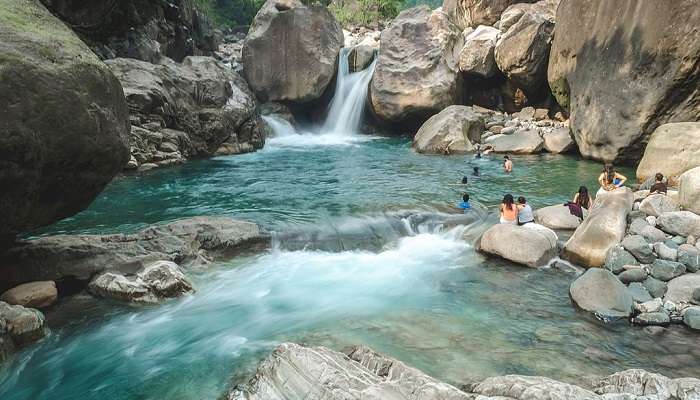
3.5 km from Cherrapunji Bus Stand, Arwah Cave is a huge cave located in the Khlieh Shnong area of Cherrapunji in Meghalaya. Known for its limestone formations and fossils, it is one of the popular caves in Meghalaya and among the spectacular tourist places in Cherrapunji. The cave is open from 6 a.m. to 6 p.m.
How To Reach The Caves
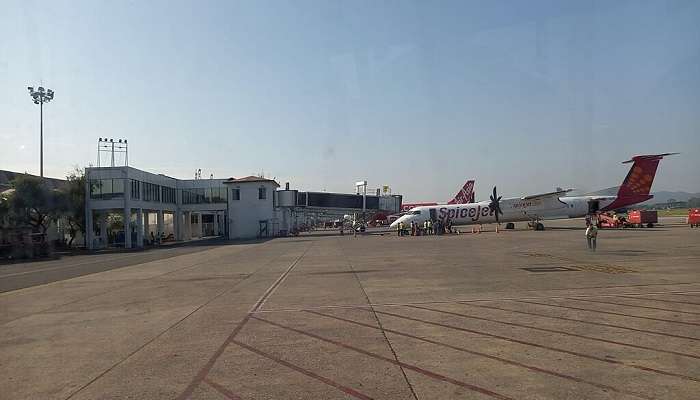
The most common route to the caves is Guwahati—Shillong—Cherrapunjee—Arwah Cave. Here is how to reach the caves.
By Air – The nearest airport to Arwah Cave is Guwahati Airport.
By Train – The nearest railway station is Guwahati Railway Station, about 143 km away.
By Road- You can travel from Guwahati to Shillong in shared taxis/cars, which leave from the Guwahati Paltan Bazar stand. The ticket cost is around 170 rs per person.
Further Read: Meghalaya Travel Tips
Arwah caves are the most famous caves for which the northeastern Indian state of Meghalaya is well known. Meghalaya is steeped in natural wonders and treats for the human senses in the great outdoors. Now that you know everything you need to know about the Arwah Caves, the next step would be executing some exciting plans for your next holiday. Book your tickets now for an amazing trip to Meghalaya .
For our editorial codes of conduct and copyright disclaimer, please click here.
Cover Image Credit: Akash Mahanta for wikimedia commons
Frequently Asked Questions About Arwah Cave
What is the average temperature in Meghalaya?
In Meghalaya, during February, March, April and November, you can expect comfortable weather, with average temperatures ranging from 20°C to 25°C. The coldest month is January with an average maximum temperature of 18°C.
What is the best time to visit Arwah Cave?
If you plan a holiday in this paradise, the best time to visit Meghalaya is somewhere between October and April. During this time of the year, the weather is pleasant, and as you explore the different places across the state.
Is there any entry fee to visit the cave?
The fees to the caves are as follows: Rs. 20 for Adults, Rs. 10 for Children, Rs. 100 for Guide & Rs. 50 for Camera.
What precautions should be taken while visiting Meghalaya?
Since Meghalaya is a region in India with the most rainfall, be careful around slippery land and wear and carry synthetic and easy-to-dry clothes.
What to carry while visiting Arwah Cave?
It is important to carry enough water, food items, mosquito repellant, and an umbrella.
People Also Read:
Khambhalida Caves Edakkal Caves Lahesh Cave

We all have to begin somewhere. This is where I start and I hope that my writings encourage you to begin. To new beginnings and conquering new places!











